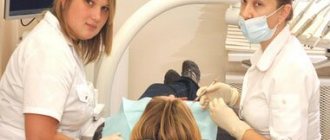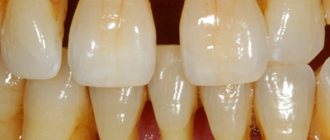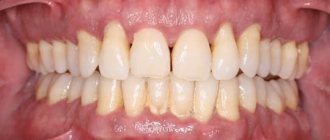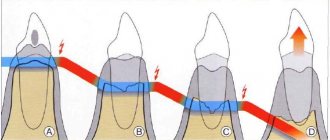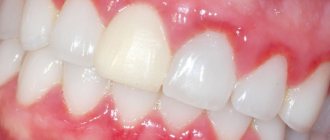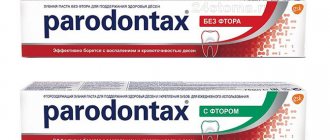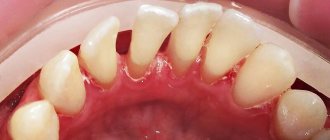From this article you will learn:
- what is periodontitis - symptoms, photos,
- anti-inflammatory therapy regimen,
- modern methods of treating periodontitis.
The article was written by a dentist with more than 19 years of experience.
Periodontitis is an inflammatory disease of the gums, which is accompanied by increasing destruction of the attachment of teeth to the bone tissue and soft tissues of the gums, which over time leads to tooth mobility. Periodontitis can appear in the area of only 1-2 teeth - in this case it is called localized, or it can be generalized (in the area of most teeth).
Most often, patients consult doctors with chronic generalized periodontitis, in which the gums of almost all teeth are inflamed. As a rule, most of these patients have a long history of self-medication of sore and bleeding gums (ie, symptoms of catarrhal gingivitis). Moreover, it is ineffective treatment or no treatment at all for gingivitis that leads to its gradual transformation into generalized periodontitis.
Periodontitis: generalized (Fig. 1) and localized (Fig. 2-3)
The causes of the localized form of periodontitis are local traumatic factors. This could be an overhanging edge of a filling or an artificial crown that injures the gums in the interdental space. The reason may also be “premature contacts” between the upper and lower teeth, which can appear either from natural causes or if the filling on the chewing surface or the crown is made a little higher than necessary.
Another common reason is when a dentist, when restoring a damaged tooth with a filling, incorrectly forms a contact point between the teeth in the interdental space. The lack of tight contact leads to constant food getting stuck in the interdental space and the development of inflammation. In the localized form (as opposed to the generalized form), symptoms of periodontitis occur only in teeth exposed to the traumatic factor.
What is periodontitis?
Periodontitis, or, as it is popularly called, dental periodontitis, is an inflammatory disease of the periodontal tissues that surround the tooth (gums, dental ligament and surrounding jaw bone). In professional terms, periodontitis is an inflammation of the ligaments of the tooth.
Periodontitis can be localized, that is, spread to the area of one or two teeth, or generalized, that is, affect most of the dentition. If a patient has periodontitis, it is usually chronic. Therefore, the main task of a specialist is to identify the cause of the disease, prescribe the correct treatment and, most importantly, prevent subsequent exacerbations and complications.
What are the signs of periodontitis?
The initial signs of periodontitis are bleeding gums when pressing on them or when brushing teeth, bluish or red gums, and bad breath. Already in the later stages of the disease, tooth mobility and visible exposure of their roots appear, which indicates a severe and advanced form of the inflammatory process. When periodontitis becomes chronic, the tissues surrounding the tooth are “reabsorbed” and pathological gum and bone pockets are formed. As a result, the tooth gradually becomes loose and falls out.
It is necessary to distinguish the exposure of roots during periodontitis from the so-called gum recession - a decrease in the height of the gingival margin, as a result of which the root of the tooth is exposed, in other words, “sliding” or gum atrophy. Unlike periodontitis, recession is not caused by inflammation and does not entail the formation of pathological pockets and loosening of teeth. Additionally, in most cases, gum recession can be successfully treated.
Complications
Inflammatory processes are extremely undesirable for the human body. When the doctor understands what causes periodontitis, why it is dangerous, and how to determine its type, it is possible to develop a therapeutic regimen and eliminate negative manifestations in a short time. However, most often patients run to the clinic when it is already too late. Bacterial flora and toxins gradually penetrate the bloodstream and are delivered to all organs and systems. As a result, acute respiratory viral infections, endocrine disorders, and systemic diseases are provoked. In its advanced form, the walls of blood vessels become thinner, and atherosclerosis develops, which leads to strokes and heart attacks.
Symptoms of the complicated stage:
- severe toothache;
- constant weakness, fatigue, apathy;
- persistent increase in body temperature;
- discharge of pus from the alveoli;
- destruction of alveolar processes.
What are the causes of periodontitis?
Understanding the causes of the disease is a very important point, which helps the doctor correctly determine how to treat gum periodontitis. The disease can be triggered by both general and local factors. Common causes include diseases of the gastrointestinal tract, diseases associated with pathology of the endocrine system, some gynecological and urological diseases, sexually transmitted infections, and a weakened immune system. Local, or local, factors are missing teeth, malocclusion, incorrectly installed fillings or crowns, which mechanically irritate the gums and create conditions for the accumulation of bacterial plaque. A significant role is played by the specific microbial flora of the oral cavity, which occurs in some patients and causes periodontitis. But the main factor in the development of periodontitis is poor oral hygiene.
How is periodontitis diagnosed?
It is possible to determine whether a patient has periodontitis or not already at the first appointment, focusing on his complaints and the condition of the oral cavity. Moreover, when diagnosing the disease, special tests are used, the most popular of which is the Parma index. It works as follows: a special Schiller solution is applied to the gums, which reacts to unhealthy tissues and colors them in a bright color, revealing the source of inflammation. There is also an index that determines the level of bleeding, and a Russell test that reveals the condition of not only the gums, but also the bone tissue.
X-ray studies, which determine the degree of the disease that has arisen, are the main ones in the diagnosis of periodontitis. For such a study, you can use a radiovisiograph (a device for conventional targeted X-rays), or an orthopantomograph (an extraoral device that can take a picture of both jaws at once). However, the most informative method is considered to be extraoral cone-beam computed tomography, which allows layer-by-layer examination of each piece of the jaw and tooth in three-dimensional format.
Currently, the Florida probe computer diagnostic technique has appeared, which allows you to most accurately determine and record the depth of periodontal pockets - the main pathological manifestation of periodontitis. The examination is easily tolerated by patients and helps the doctor prescribe appropriate treatment.
For periodontitis, a microbiological study is also carried out, with which you can study the microflora of the oral cavity and determine the sensitivity of microorganisms to antibiotics for a more accurate selection of drug treatment.
Another mandatory test is a blood test. It allows you to identify the cause of the disease, which may be either the initial stage of diabetes or a chronic infectious process in other organs and systems, as well as disorders associated with hormonal levels and metabolism.
In the process of diagnosing periodontitis, consultation with related specialists is often required to identify and treat concomitant diseases.
Gum massage for periodontitis
With the help of simple manipulations, you can improve trophism and strengthen blood vessels in damaged periodontal tissues. The method is used in combination with folk recipes and traditional treatment.
It is necessary to wash your hands thoroughly and treat them with an antiseptic composition. You will need your thumb and index finger to wrap around the gum surfaces. If severe pain occurs, you must stop all manipulations and contact a dental clinic. Massage techniques:
- Stroking movements. The procedure not only begins, but also ends with this stage.
- Trituration. The degree of pressure gradually increases.
- Squeezing out the contents of periodontal pockets with intense pressure.
- Squeezing the oral and vestibular surfaces for 5-7 seconds (no more).
It is better to use essential oils. This will ensure sufficient glide.
How is periodontitis treated?
Successful treatment of periodontitis can only be achieved in a well-coordinated team of “doctor plus patient”. Much depends on the doctor, but even more depends on the patient himself. The doctor is responsible for the treatment, and the patient is responsible for maintaining the result, because periodontitis is a chronic disease.
Treatment methods for periodontitis are divided into medicinal and surgical. In case of minor inflammation caused by dental plaque, the doctor thoroughly cleans the teeth, eliminates conditions that contribute to the retention of microbial plaque, polishes the surfaces of the teeth and applies a therapeutic bandage with medication to the inflamed area. If a deep periodontal pocket forms and severe pain occurs, the patient may be prescribed antibiotics. When treating severe periodontitis, it is necessary to resort to more serious (surgical) procedures, such as curettage and flap operations. But in any case, periodontitis requires complex treatment, including professional hygiene, drugs for local and internal use, and, if necessary, surgical procedures.
There is also a hardware method for treating periodontitis - Vector. The method involves using ultrasound in combination with medications aimed at fighting microbes and stimulating healing. The Vector device is used both as an independent technique and in combination with surgical treatment.
Treatment
Pharmacy chains offer many effective drugs to suppress the pathological process. There are also separate recommendations, the observance of which will help speed up recovery. The patient should not self-medicate. It is important to first consult with a dentist and develop a therapeutic regimen depending on the severity of the disease.
Local drug treatment of periodontitis
If there is increased pain and worsening infection in the mouth, doctors often prescribe antibiotics. For example, Amoxicillin, Tsiprolet, Lincomycin, etc. are used.
The exact dosage must be calculated by the dentist. Additionally, the use of probiotics to restore normal microflora (Linex, Lactobacterin) is indicated.
Ointments and gels
Products for external application are quickly absorbed by soft tissues and kill pathogenic microorganisms. This eliminates not only the cause of the pathology, but also accelerates the regeneration of damaged fibers.
Preparations containing lidocaine are most often prescribed. For this reason, you need to contact a dental clinic in advance to exclude possible allergies due to intolerance to the components. The most popular means:
- Kamistad.
- Solcoseryl.
- Holisal.
- Metrogil Denta et al.
Rinse aids
Liquid formulations help fight bacteria, relieve inflammation and promote rapid healing of wounds. At the same time, the enamel becomes lighter and cleaner, and your breath becomes fresher. On store shelves you can find solutions such as Lakalut, Splat, Parodontax.
Vitamins
During therapy, it is necessary to take vitamin complexes. To quickly heal wounds, normalize metabolic processes and strengthen the immune system, various additives are used in the form of applications to pathological areas.
Professional oral hygiene
This is the main guarantee of healthy teeth and gums. If plaque or tartar has accumulated, it is recommended to contact your dentist. Some useful skincare tips:
- clean in the morning and evening;
- flossing throughout the day;
- use of an irrigator;
- rinsing with special rinses after meals;
- regular massage.
Diet
The menu should include a lot of fresh fruits and vegetables. The most suitable are apples, pears, carrots, bell peppers, cucumbers, berries, citrus fruits, and nuts. To keep your enamel strong, you need to eat more cheese, cottage cheese, beans, dried apricots and other foods high in calcium.
You need to give up fried foods, smoked foods, and too spicy foods. The problem is also aggravated when drinking hot drinks.
Surgery
If the patient knows firsthand what oral periodontitis is and suffers painful symptoms, surgical intervention is indicated. Doctors resort to similar methods when dental units are very loose. Popular methods: splinting, patchwork, open and closed curettage.
Plasmolifting
This is the most effective method after surgery. The procedure for introducing plasma into the gums helps improve tissue regeneration, fights inflammation, and reduces bleeding.
Orthopedic structures
If there are no incisors, canines or molars, dentures are installed. You cannot do without prosthetics, otherwise malocclusion may appear and further progression of the disease.
Physiotherapy
Physiotherapeutic methods show effectiveness as part of complex therapy in combination with pharmaceutical drugs and surgery. After a course of procedures, blood circulation and metabolic processes improve, periodontal tissue is strengthened and restored. In most cases, dentists prescribe:
- ultrasound;
- balneotherapy;
- light therapy;
- electrophoresis;
- darsonvalization, etc.
What are the surgical treatments for periodontitis?
Surgical treatment of periodontitis is important in the later stages of the disease with severe tooth mobility and deep periodontal pockets. This is, first of all, a curettage procedure, which involves removing dental plaque and pathological granulation tissue from under the gums. If the depth of the periodontal pocket is up to 4 mm, closed curettage is performed without opening the gum; if it is more, open or flap surgery is performed, when it is necessary to detach the periosteal flap, fold it back and clean out the pocket. This procedure is always performed with pain relief and is well tolerated by patients.
In addition to the procedures described above, splinting is performed for periodontitis, which secures loose teeth.
Is it possible to eliminate periodontitis with a laser?
Laser treatment of periodontitis is one of the most effective and minimally invasive ways to combat the disease, which is one of the stages of complex treatment. The laser has cleansing and antibacterial properties. During the procedure, each periodontal pocket is treated for a certain time, sufficient for the laser light beam to destroy pathogenic bacteria. The procedure is bloodless and virtually painless. However, a good effect can only be obtained with an integrated approach to the treatment of periodontitis.
Is it true that periodontitis can be cured with implantation?
Implantation is a method of combating not periodontitis itself, but its consequences. At a later stage of the disease, teeth become loose and fall out, so they have to be replaced with implants. It should be understood that dental implantation for periodontitis has its own difficulties and limitations, since bone tissue is absorbed in this disease. Its sufficient volume is the main condition for successful installation of implants. If periodontitis is in an advanced stage, implantation can be very difficult or even impossible due to a lack of bone volume. That is why patients should begin treatment as early as possible in order to do everything possible to preserve their teeth, and if they are lost, do not miss the opportunity to restore them with implants.
In any case, before installing implants, it is necessary to transfer periodontitis to the stage of remission (stabilization) or, if possible, eliminate the cause of its occurrence.
Antibiotics
This group of medications is represented by an impressive list of drugs with both narrowly targeted and broad spectrum of action. Before taking antibiotics, be sure to determine the type of bacteria that caused the development of periodontitis. Otherwise, treatment may not only be useless, but also harm the patient’s health.
Each antibiotic has its own dosage and administration characteristics, which must be strictly followed. For example, if the drug was prescribed three times a day, this means that it should be taken every 8 hours, without deviating from this schedule. If we are talking about a strong antibacterial agent, then it can be taken once every day.
What consequences can untreated periodontitis lead to?
Loss of teeth
The advanced stage of the disease destroys the soft and hard tissues around the teeth, which leads to their loss.
Deterioration of conditions for implantation
As mentioned earlier, with severe periodontitis, the volume of the jaw bone is significantly reduced, which makes it difficult to install implants, requiring preliminary bone growth, and in extremely severe cases makes implantation impossible.
The occurrence of other diseases
Periodontitis contributes to diseases of the gastrointestinal tract, diseases of the lungs, heart and even the formation of blood clots.
How to avoid further exacerbation of the disease?
This is where the patient becomes the main member of a well-coordinated doctor-patient team. To maintain the results obtained after treatment of periodontitis, you should brush your teeth correctly and regularly, following all the recommendations of the treating dentist, since with periodontitis, individual oral hygiene differs from usual. In particular, along with a regular brush and paste, there is a need to connect additional hygiene products: dental floss, various brushes for teeth, an irrigator, etc.
In addition, it is necessary to come to the dentist for professional cleaning at least once every six months, and for people with chronic periodontitis even more often - once every three months. Good hygiene is an excellent prevention of periodontitis and the only way to maintain the results of treatment.
Prevention
Is it possible to avoid inflammation in periodontal tissues? Of course, and in most cases, careful hygiene and regular professional cleaning at the dentist are sufficient for prevention. It is also worth eating more solid foods - fresh vegetables, fruits, nuts. Such food gives the gums the necessary chewing load, promotes self-cleaning of teeth and supplies the body with valuable microelements. However, an additional course of dietary supplements containing calcium, fluoride and vitamin B will also not be superfluous. And of course, you shouldn’t put off correcting your bite, replacing missing teeth and treating caries. Then the likelihood of developing chronic periodontitis will be minimal.
How much does it cost to cure periodontitis? What does the cost consist of?
The price for periodontitis treatment depends on the complexity of the disease, whether surgical procedures will be performed and to what extent.
Important!
Folk remedies in the form of all kinds of herbal infusions do not help with periodontitis. They can bring temporary relief and mask the problem, but mouth rinses cannot radically solve it. Neither home treatment nor the miraculous toothpaste from TV commercials will help get rid of periodontitis. Rinses and toothpastes are just one of the auxiliary components in complex treatment. If you have periodontitis or suspect it, contact the dentist for timely diagnosis, since it is in the early stages of the disease that doctors have a lot of opportunities to help you!
Remedies for reducing tooth sensitivity
Due to the exposure of the necks and roots, the teeth of patients with periodontal disease become much more sensitive to the effects of various irritants - thermal, chemical, mechanical. Patients experience significant discomfort when eating spicy or sour foods, drinking hot or cold foods and drinks. To eliminate this unpleasant symptom, various means are used, including calcium gluconate, which is administered by electrophoresis (medicine applications combined with a weak electric current).
To combat hyperesthesia and eliminate other symptoms, you can also use special toothpastes. In particular, the minerals potassium citrate and hydroxyapatite, as well as thermal mud, which are contained in ASEPTA Sensitive toothpaste for sensitive teeth, help reduce tooth sensitivity and strengthen enamel. It also contains extracts of medicinal plants that have anti-inflammatory and antimicrobial effects.
